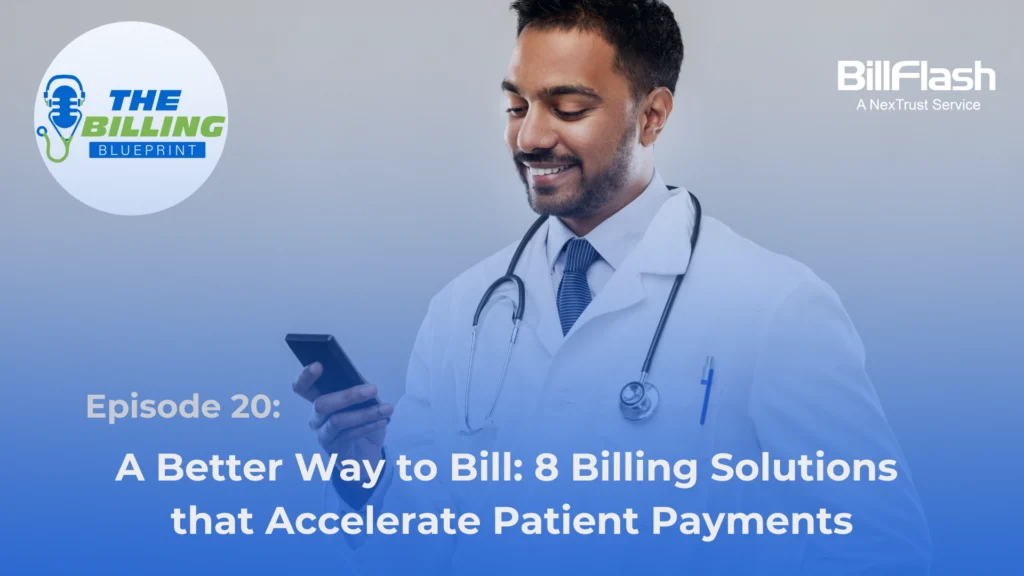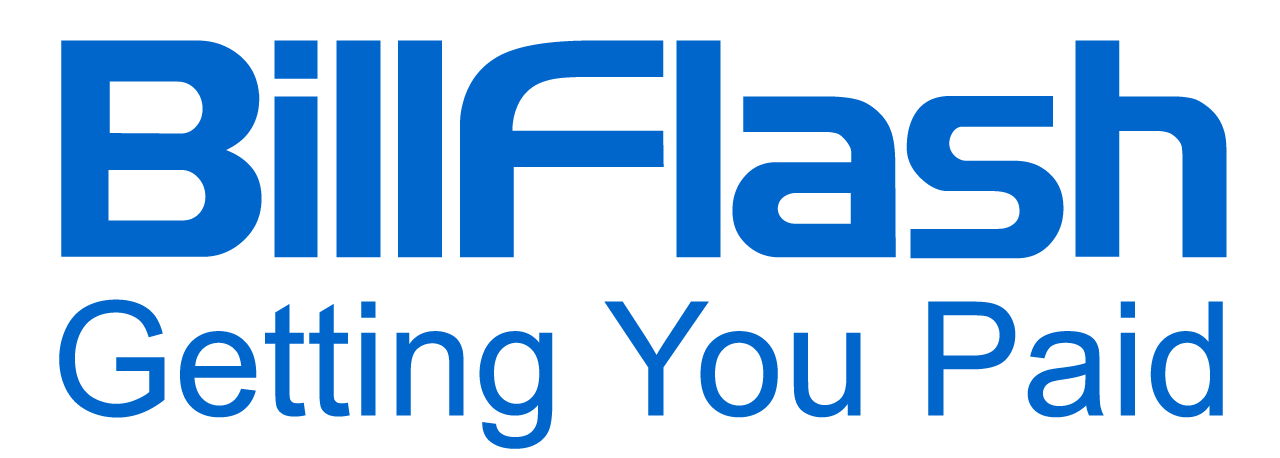In this episode, discover 8 smart billing solutions that help practices get paid faster—without overwhelming staff or patients.
We explore the everyday challenges practices face, from patients ignoring paper bills to limited payment options and time-consuming manual processes. Learn how smart billing solutions from BillFlash—like eBills, QR codes, pre-visit billing, and automated reminders—help simplify collections, improve communication, and boost cash flow.
Say goodbye to payment delays and billing headaches—and hello to faster payments, happier patients, and a more efficient revenue cycle.
Ready to streamline your billing with tools that actually work? Tune in to this episode now!

Transcript
Narrator: 00:00
Welcome to the Billing Blueprint Podcast, your go to resource for innovative medical billing solutions. Each episode we explore the latest industry trends and share proven strategies to help your practice streamline operations and get paid faster. Now here are your hosts, Brad and Sarah.
Okay, so we've got some really interesting stuff to dig into today.
Sarah: 00:24
Yeah, it seems like everyone's trying to figure out how to, you know, get paid faster.
Brad: 00:28
Exactly. Get those medical practices running like well oiled machines. And what's cool is we've got this mix of like, old school methods that are still surprisingly effective and then some really cutting edge stuff too. So let's get into it.
Sarah: 00:42
Sounds good. Where do you want to start?
Brad: 00:44
Well, I was struck by this whole thing about paper bills. I mean, you'd think in this day and age everyone would be all about the digital stuff, right?
Sarah: 00:51
You'd think so.
Brad: 00:51
But a whopping 74% of healthcare consumers, they still prefer good old fashioned paper bills. It's kind of wild, right?
Sarah: 01:01
It is, it is. And I think there are a few reasons for that. I mean, you mentioned the tangible reminder aspect, right?
Brad: 01:05
That physical piece of paper just sticks in your mind more than email, maybe?
Sarah: 01:09
Exactly. And then, you know, there's also this sense of security and formality that some people associate with paper bills. It's like maybe especially for older folks who aren't as comfortable with, you know, technology.
Brad: 01:20
Right. Or just anyone who's not like super tech savvy. It really highlights that we can't just assume everyone wants to go digital.
Sarah: 01:27
Totally. And I think it's important to offer options that cater to, you know, everyone's needs and preferences.
Brad: 01:34
Absolutely. But it's not just about, you know, sticking with the same old paper bills either. Yeah. This whole idea of putting QR codes on those paper bills, that's pretty slick.
Sarah: 01:42
Oh yeah, that's smart. It's like, you know, meeting people where they are. They get that paper bill they like, but then they can just scan the.
Brad: 01:48
QR code, boom, right to the online payment portal. They use their bill in seconds.
Sarah: 01:53
Super convenient. And it's like a nice little bridge between, you know, the physical and the digital world.
Brad: 01:58
Totally. And here's where things get even more interesting. Those paper bills, they can be more than just like a demand for payment. You can slip in little PDF inserts with health updates or even, you know, promotions for other services the practice offers. It's like turning a bill into a marketing opportunity.
Sarah: 02:19
Right. It's like, yeah, you're not just sending them a bill, you're engaging with them, building a Relationship.
Brad: 02:25
Exactly. So paper bills, they might not be dead just yet, but where things are definitely speeding up is with E bills.
Sarah: 02:33
Oh, yeah, those are definitely a game changer.
Brad: 02:36
They are. They are sent straight to your phone or your email. I mean, think about how often we all check our phones.
Sarah: 02:41
Constantly. I know I do.
Brad: 02:43
Right. And that's the beauty of it. The material we got Sundays people are 34% more likely to pay when they're reminded electronically.
Sarah: 02:52
It just makes sense. Right. It's like the reminder's right there. The link to pay is right there. You don't have to go searching for anything.
Brad: 02:58
Totally. No more waiting for the mail, no more digging through piles of paper. And for the practice, it saves so much time and hassle. No more printing, no more envelopes.
Sarah: 03:07
Exactly. And it reduces the risk of errors, too. Everything's automated.
Brad: 03:11
It's just a more efficient system all around.
Sarah: 03:13
Yeah.
Brad: 03:13
And speaking of efficiency, let's talk about pre visit billing.
Sarah: 03:16
Ooh, that's a good one.
Brad: 03:18
Yeah. This is all about getting paid before the patient even steps foot in the office.
Sarah: 03:21
So how does that work?
Brad: 03:23
Basically, you tell the patient up front what they're likely to owe.
Sarah: 03:27
Okay.
Brad: 03:28
You can send them a secure link to a payment portal. They can see exactly what the charges are.
Sarah: 03:32
So there are no surprises.
Brad: 03:33
Exactly. And you know what? Nearly 70% of patients, they actually prefer to know the cost ahead of time.
Sarah: 03:39
I can see why. It just makes things so much less stressful.
Brad: 03:42
Totally. And it helps build trust with the patient, too. They know you're being upfront with them. Plus, for the practice, it cuts down on all that chasing payments after the fact.
Sarah: 03:52
Yeah, it streamlines the whole process.
Brad: 03:54
So we've got the bills going out faster. We're even getting paid up front in some cases. But what about those times when a patient just forgets to pay?
Sarah: 04:02
Oh, that happens. Life gets busy.
Brad: 04:04
It does, it does. That's where these pay reminders come in.
Sarah: 04:08
The gentle nudges.
Brad: 04:09
Exactly. They're automated reminders, usually sent by text or email. You can set it up to send, like, up to three reminders a month. And it's all automated, so it's not like someone has to sit there and manually send out reminders.
Sarah: 04:21
Right. That saves a lot of time.
Brad: 04:23
It does, it does. And the goal is to catch those forgetful patients before their bill goes to collections.
Sarah: 04:29
Which benefits everyone, really.
Brad: 04:31
It does. It does. Now, everyone has their favorite way to pay for things, right?
Sarah: 04:35
Oh, yeah, absolutely.
Brad: 04:36
Whether it's groceries or online shopping, we all have our preferences. And the same goes for Medical bills.
Sarah: 04:42
Makes sense.
Brad: 04:43
So it's super important to offer a variety of payment options. Not just checks and credit cards, but things like Apple pay, Google pay, all that good stuff.
Sarah: 04:51
Right. You got to keep up with the times.
Brad: 04:53
You do, you do. And get this. Practices that offer those digital and mobile payment options, they see a 45% increase in on time payments.
Sarah: 05:03
Wow, that's significant.
Brad: 05:05
It is, it is. It's all about making it as easy as possible for people to pay. You remove the friction, the payments come in faster.
Sarah: 05:11
Yeah. No one wants to jump through hoops to pay a bill.
Brad: 05:14
Exactly. Now let's talk about those big medical bills. The ones that can be, you know, a real financial strain.
Sarah: 05:21
Right. Those can be tough.
Brad: 05:23
That's where flexible payment plans come in.
Sarah: 05:25
Okay, tell me more about those.
Brad: 05:26
So instead of having to pay the whole bill at once, patients can spread out the payments over time.
Sarah: 05:32
That makes it much more manageable.
Brad: 05:33
It does, it does. And the cool thing is practices that offer installment plans, they actually see a 30% boost in collections on those outstanding balances.
Sarah: 05:43
So it helps them get paid, and it helps patients manage their finances. Win. Win.
Brad: 05:49
Exactly. And there's this model where the practice actually gets the full payment upfront, but the patient makes those smaller payments to a third party.
Sarah: 05:57
Oh, that's interesting.
Brad: 05:57
Yeah. So the practice gets their money right away, but the patient doesn't feel overwhel.
Sarah: 06:01
That's a smart system.
Brad: 06:03
So we've covered a lot of individual strategies, but there's this bigger picture thing called revenue cycle management, or RCM billing.
Sarah: 06:09
Rcm. Okay.
Brad: 06:10
It's basically a system for managing the whole financial side of a patient's journey.
Sarah: 06:15
So from the moment they make an appointment to when they pay their bill.
Brad: 06:18
Exactly. And it's all about automating and streamlining.
Sarah: 06:21
The process, which means fewer errors and faster payments.
Brad: 06:25
You got it. RCM systems can handle things like insurance verification, claim submission, payment processing, all that stuff.
Sarah: 06:33
So it frees up the practice staff to focus on patient care.
Brad: 06:37
Exactly. Now, even with all these proactive measures, there were going to be some patients who, you know, just don't pay.
Sarah: 06:43
Right. It's inevitable.
Brad: 06:44
So we got to talk about collections, but there are these integrated collection services that can help.
Sarah: 06:49
Okay, what are those?
Brad: 06:50
They basically allow the practice to keep more control over the process.
Sarah: 06:55
So they're not just handing everything over to a third party agency.
Brad: 06:59
Exactly. The practice sets the rules for when an account gets flagged for collections.
Sarah: 07:03
Okay.
Brad: 07:04
And there's always a step for manual review so someone can look at the situation and make sure it's handled appropriately.
Sarah: 07:09
That's important.
Brad: 07:10
It is. It is. And any payments collected through these integrated services, they go straight to the practice. No third party fees.
Sarah: 07:17
So it's more efficient. And it's probably less stressful for the patient, too.
Brad: 07:21
Totally. So to recap, we've got eight key solutions here. Mailed bills with QR codes, E bills, previson billing, pay reminders, diverse payment options, flexible payment plans, RCM billing, and integrated collections. It's a whole toolkit for getting paid faster and keeping patients happy.
Sarah: 07:41
It's like a multi pronged approach. You gotta use the right tool for the right job.
Brad: 07:44
Exactly. It's about finding the right combination of strategies for your practice and for your patients. Absolutely. So as you think about all these solutions, here's a question for you listeners. What one change could you make today that would have the biggest impact on your billing process and your patient experience? Maybe it's time to revisit some of these ideas and see what resonates with you.
Sarah: 08:04
Food for thought.
Brad: 08:05
Thanks for joining us on this deep dive. We'll catch you next time.
Narrator: 8:08
Thanks for tuning into the Billing Blueprint podcast. For more insights or to dive deeper dive deeper into today's topics. Head over to billflash.com. Don't forget to subscribe and we'll catch you next week with more strategies to keep your practice running smoothly and getting paid faster
Sources:
8 Innovative Medical Billing Solutions That Accelerate Patient Payments

